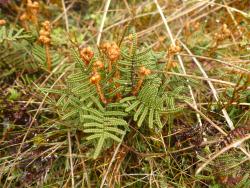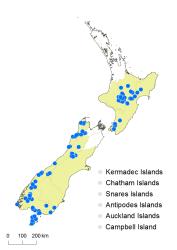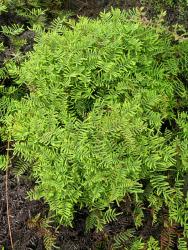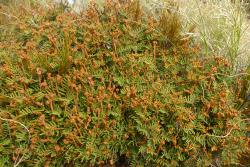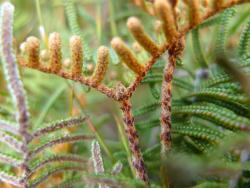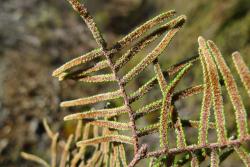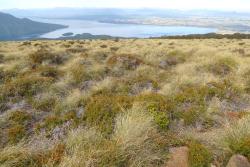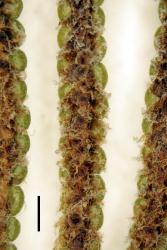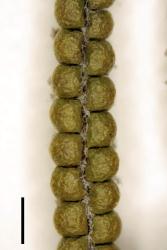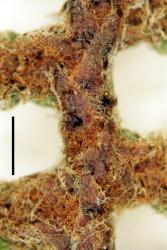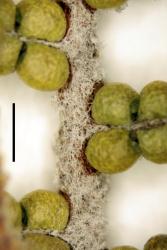- ≡ Mertensia alpina (R.Br.) Poir., Encycl. Suppl. 3, 670 (1814)
- ≡ Platyzoma alpinum (R.Br.) Desv., Mém. Soc. Linn. Paris 6: 199 (1827)
- ≡ Calymella alpina (R.Br.) C.Presl, Tent. Pterid. 49 (1836)
- ≡ Gleichenia dicarpa var. alpina (R.Br.) Hook.f., Bot. Antarct. Voy. II (Fl. Nov.-Zel.) Part II, 5 (1854)
- ≡ Gleichenia circinnata var. alpina (R.Br.) Dobbie, New Zealand Ferns ed. 4, 44 (1951) – as G. circinata var. alpina
- ≡ Pteris platyzoma Christenh. in Christenhusz et al., Phytotaxa 19: 22 (2011) nom. nov. pro Gleichenia alpina R.Br. 1810 (non Pteris alpina Field 1890)
Rhizomes long-creeping, 1–2.5 mm diameter; rhizome scales ovate or orbicular, 0.6–1.9 mm long, 0.4–1.1 mm wide, brown, shortly-setose. Fronds 85–1250 mm long. Stipes 60–660 mm long, distally scaly. Laminae 40–1100 mm long, 40–220 mm wide. Rachis buds usually extending 1–3 (rarely 0 or 4–9) times; rachis bud scales ovate, 1.0–2.7 mm long, 0.5–1 mm wide, brown, ciliate. Rachis buds without accessory leaflets. Pinnae 25–230 mm long, 15–120 mm wide; with 0–1 (rarely 2) pseudodichotomous forks (excluding growth from pinna buds); pinna buds (in pinnae with at least 1 fork) usually extending 1–5 (rarely 8) times. Proximal-most costae 4–22 mm long, scaly but glabrescent in old fronds. γ costae (where not proximal-most costa) 5–17 mm long, with 0–2 pairs of costal leaflets. β costae 11–73 mm long, with 4–14 pairs of ultimate leaflets; adaxially with brown or pale branched-scales with curly branches that form a lanate mass; abaxially with dark-brown or orange-brown, ovate, ciliate scales, 680–1300 µm long, 340–780 µm wide, lacking stiffly stellate scales. Longest ultimate leaflets 8–41 mm long, with 11–48 pairs of ultimate segments. α costae adaxially with pale, branched hair-like scales percurrent; abaxially with ovate, dark-brown to orange-brown, ciliate scales, 340–960 µm long, 250–520 µm wide, percurrent. Ultimate segments 0.5–0.9 mm long, 0.6–1.0 mm wide, ± square, abaxially pouched, apices rounded; adaxially green, ± glabrous, strongly convex; abaxially ± obscured by scales of α costa, but white, with small branched pale scales or ± glabrous. Sori superficial but obscured by the strongly pouched ultimate segments and scales of α costae, each with 2 sporangia. Spores 36.4– 45.4 µm long, 41.7–50.0 µm wide (6 populations).
Gleichenia alpina is characterised by comparatively short frond axes and the dense orange-brown (becoming pale) scales that obscure the abaxial surface of the lamina. Its strongly pouched ultimate segments mean it can be confused only with G. dicarpa. From that species, G. alpina can be distinguished by: the absence of stellate scales with patent branches on the β costae; the strongly convex adaxial surface of the ultimate segments; only 0–1 (rarely 2) pseudodichotomous forks in the pinnae (excluding growth from pinna buds); the absence of accessory leaflets around the rachis bud; and pinna buds that usually extend, often more than once. In contrast, G. dicarpa has: stellate scales with patent branches (curled in Chatham Islands’ plants) on the abaxial and/or adaxial surfaces of the β costae; complanate or weakly convex adaxial surface of the ultimate segments; 1–4 (rarely 0 or 5) pseudodichotomous forks in the pinnae (excluding growth from pinna buds); usually accessory leaflets around the rachis bud; and pinna buds that extend only occasionally and rarely more than once.
North Island: Volcanic Plateau, Gisborne, Taranaki, Southern North Island.
South Island: Western Nelson, Westland, Canterbury, Otago, Fiordland, Southland.
Stewart Island.
Altitudinal range: 0–1380 m.
Gleichenia alpina occurs from the central North Island through to the South Island and Stewart Island. It grows between 680 and 1380 m above sea level in the North Island, descending to 570 m in the northern South Island and reaching near sea level in southern Westland and further south. It is absent from east of the axial ranges in the South Island except for occasional populations in Otago. It has not been recorded from Mount Taranaki.
Also Australia (Tasmania).
Gleichenia alpina occurs in subalpine bogs and scrub, and other cold, open habitats. It usually grows in the open, often growing through other vegetation, and rarely extends into forest. It favours wet ground, and is often found with Empodisma.
Infrequent morphological intermediates between Gleichenia alpina and G. dicarpa suggest this pair may hybridise (e.g., near Blackball, L.R. Perrie 6376 & L.D. Shepherd, WELT P026765; near Jackson Bay, L.R. Perrie 6758 et al., WELT P026768).
A single collection (Denniston, F. Overmars A17, WELT P026702, P026703) indicates that Gleichenia alpina hybridises rarely with G. inclusisora. Although there are few sori, they are embedded, and there are obvious scales on the abaxial surface of the ultimate segments, reflecting the involvement of G. inclusisora. However, these scales are larger, more ovate, and less-distinctly bicolorous than G. inclusisora, and the ultimate segments are abaxially more pouched, indicating the involvement of G. alpina or G. dicarpa. The large size of the scales suggests the other parent is more likely G. alpina than G. dicarpa; this is borne out by the hybrid’s chloroplast DNA sequence, which matches G. alpina (L.D. Shepherd unpub.).
No count has been made from New Zealand material of Gleichenia alpina, but n = 20 has been reported for Australian material (Tindale & Roy 2002).
The status of Gleichenia alpina in New Zealand has long been uncertain (Allan 1961; Brownsey et al. 1985). It was treated as a Tasmanian endemic by Chinnock & Bell (1998). However, New Zealand material matches Tasmanian material both in morphology and genetics (Perrie et al. 2007, 2012).



